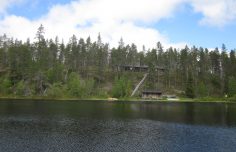A chemical process that takes place in living cells, by which some living organisms (such as green plants and algae) convert energy in sunlight into chemical energy. The compounds produced are then used to provide the energy for cells in the process of respirationA chemical process that takes place in living cells, by which living organisms use organic compounds to create energy. One of the bi-products of respiration is the gas carbon dioxide, which... More. During photosynthesisA chemical process that takes place in living cells, by which some living organisms (such as green plants and algae) convert energy in sunlight into chemical energy. The compounds produced... More most plants absorb carbon dioxide from their surroundings and the carbon is transferred to more complex molecules, such as sugars and starch. PhotosynthesisA chemical process that takes place in living cells, by which some living organisms (such as green plants and algae) convert energy in sunlight into chemical energy. The compounds produced... More is therefore a key process in the carbon cycleDescribes how carbon moves around the environment. It is an example of a biogeochemical cycle. See also carbon flux. In recent years the carbon cycle has been studied intensively in order to... More.
Related contents
-
> Värriö Subarctic Research Station
Field SitesSTATION NAME AND OWNER Värriö Research Station is managed by University of Helsinki, Department of Physics. LOCATION The area is a subarcticThe area immediately south …
> Read more -
> Carbon dioxide
GlossaryA gas (chemical formula CO2), which occurs naturally in the Earth’s atmosphere. Carbon dioxideA gas (chemical formula CO2), which occurs naturally in the Earth’s atmosphere. …
> Read more


